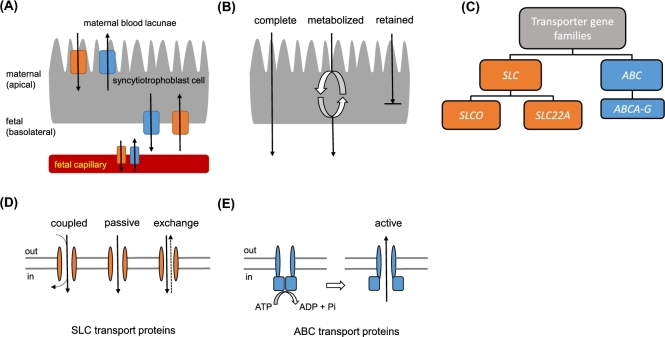Figure 1.
Transporting epithelium of the placenta and molecular transporter function. A molecule must be transported (or diffuse) through the syncytiotrophoblast and endothelium of the fetal capillary to access the fetal compartment. (A) Molecular transporter proteins are positioned in the maternal-facing apical and fetal-facing basolateral membranes and in the endothelium of fetal capillaries. (B) Possible pathways across the syncytiotrophoblast. A molecule can use transporter proteins, passive diffusion, or pinocytosis to cross the syncytiotrophoblast membranes. The molecule can be transported intact or may be metabolized first. The syncytiotrophoblast also retains certain molecules for its own use. (C) Superfamilies of genes coding for molecular transporters found in the placenta. SLC can be divided into gene subfamilies SLCO and SLC22A. ABC consist of seven gene subfamilies: ABCA, ABCB, ABCC, ABCD, ABCE, ABCF, ABCG although ABCE and ABCF are unlikely to have transporter function. A list of corresponding proteins can be found in Table 1. (D) Mechanism of transport for SLC proteins. Compounds can enter/exit the cell coupled to another molecule, passively down its concentration gradient or in exchange for another molecule. SLC transporters can be bidirectional although they mainly allow for placental uptake of molecules. (E) Mechanism of transport for ABC proteins. ABC transporters actively efflux compounds against their concentration gradient. ATP hydrolysis is required for a conformational change of the transporter protein to allow uptake and expulsion of the substrate from the cell.

